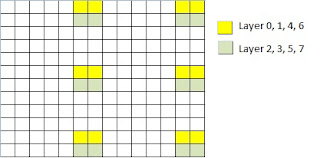Transmission Mode 9 is new transmission mode defined in LTE release 10. It extends
the concept of MIMO to 8 layers transmission. It support both SU-MIMO and
MU-MIMO, it is possible to switch between two modes dynamically.
In order to support 8 layer transmission, LTE Release 10 extends the
concept of downlink Demodulation Reference Symbols (DMRS) to 8 layers. The precoding used for reference symbols is
same as that used for PDSCH. Therefore, there is no need to explicitly signal
precoding index.
The structure of DMRS for transmission mode 9 is shown in following
figure:
To maintain the backward compatibility with Release 8/9, the structure
for DMRS is similar to that used for transmission mode 7/8. DMRS for 8 layers is
supported by having two different groups with lenght-4 Walsh–Hadamard orthogonal
cover codes. In addition to DMRS, TM9 uses CSI reference symbols introduced in
LTE release 10 for more effective estimation of CSI.
To schedule data using transmission mode 9, a new DCI format 2C is introduced
in LTE release 10. DCI 2C is based upon DCI format 2B, which is used for transmission
mode 8. The number of layers can also be defined dynamically. The base station
can schedule data on layers one to eight (antenna port 7 to 7+n).
The maximum number of codewords supported in transmission mode 9 is two
even for eight antenna ports. This is same as maximum supported in different
transmission mode in LTE release 8 and 9. The reason for this is, an increase
in number of codewords would have resulted in increased signaling overhead. Various
researches have proved that that increase in data rate by increasing number of
codewords is very limited.
What are the benefits of using
transmission mode 9.The answer to this question is, high cell edge data rates,
better interference handling by base station, and therefore, improved coverage.
TM9 can be combined with carrier aggregation and eICIC to create a highly
spectrum efficient network.
